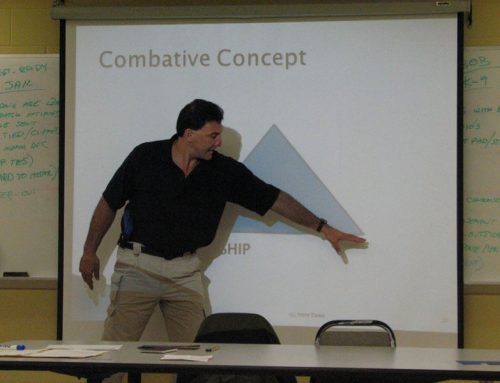 In the world of threat management and protection there are three ways to handle a threat as it develops form a potential threat to an actual physical attack—listed in preferred order: threat avoidance, threat mitigation and threat defense.
In the world of threat management and protection there are three ways to handle a threat as it develops form a potential threat to an actual physical attack—listed in preferred order: threat avoidance, threat mitigation and threat defense.
For example if you couldn’t avoid verbal argument with someone and they started to raise their voice, you could mitigate the threat by not shouting back at them adding fuel to the fire, trying to do everything and anything you can to defuse the situation to lower the probability of the threat progressing to a physical attack. Failure to avoid or mitigate the threat and its progressing to a physical attack would result in only one remaining option and that is to defend against the physical threat.
Threat Avoidance results in the easiest and least amount of threat impact. Mitigation takes more time and effort than avoidance, whereas defense is the least desirable, as the price tag for a physical confrontation is considerably higher. The best of these three is avoidance so let’s focus our scope of study directly on this option.
The very first step to threat avoidance is threat identification, whether natural—such as inclement weather or manmade such as a home invasion or kidnapping. Any criminal or terrorist who has the motivation, capability, and opportunity to mount attacks against you or your family can be considered a potential threat.
Looking at it from the predator’s perspective—you and anyone or anything of value or importance to you, can be considered targets. Being able to change your perspective allows you to identify and effectively manage real-world threats. Thus, one method of identifying any potential threat is to assume the predator’s perspective.
For example, look at your home from the predator’s perspective—does it offer them any opportunity to satisfy their motivations and employ their capabilities? Do you have unlocked doors, or open windows or tools you may have left in the yard such as ladders, screwdrivers and the like which they may use to ply their craft? The very first step to avoiding the threat of a home invasion is to not make it so easy for a predator to select your home as a target.
Criminals and terrorists do not possess superhuman capabilities. They know what they need to do, and in what order to be successful. They know they have to get everything correct in order to be successful. More importantly, they know you only have to prevent them from having that opportunity for them to fail.
The fact is criminals all have a menu of choices from which they must choose. Fortunately for us, that menu is limited. You cannot bomb the world trade center without explosive materials and you cannot take money from a victim who fails to show up for your robbery.
 The benefit of threat avoidance is that it allows you to make realistic risk-based assessments and the more effective your assessments, the better your ability to manage a threat. If you can accurately assess and act on that assessment early—that is prior to a threat progressing to an actual attack, then you hold all the cards. This principle helps to set your threat management priorities and stay one step ahead of a motivated predator.
The benefit of threat avoidance is that it allows you to make realistic risk-based assessments and the more effective your assessments, the better your ability to manage a threat. If you can accurately assess and act on that assessment early—that is prior to a threat progressing to an actual attack, then you hold all the cards. This principle helps to set your threat management priorities and stay one step ahead of a motivated predator.
One of the most often overlooked, yet easiest to understand, preventative concept is to altogether avoid a potential threat—don’t be there in the first place—do not purposefully place yourself in harm’s way!
As easy as it may sound, you would be surprised at how many people will not follow this simple admonition of the professionals. They generally blow it off and say such things as “Well, I’m going anyway,” or “Nothing’s going to happen.”
A potential threat, say confronting an intoxicated aggressive young male may not manifest into an actual threat. Of course there exists a higher probability that it will, if you are in a bar district at 2:00 AM, and much less likely if you are asleep in your bed at home – so simply leaving the bar scene early or not going reduces this threat significantly.
There are many different levels of threat out there ranging from what you may consider unprofessional or inappropriate behavior all the way to the opposite end of that spectrum resulting in actual physically threatening behavior. The greater the risk the greater the amount of effort it will take to mitigate or defend against it again supporting why it is best to avoid it altogether.
Many times it is not possible to completely avoid a threat but the possibility should not be overlooked. For example, at the height of a blizzard, you may not want to go out in it for a Sunday drive. If you are planning on travelling to a foreign country and you are aware from watching the news that country is in the middle of extreme civil unrest or sweeping anti-American sentiment then you may not want to get on an airplane bound for that country especially wearing an “America love it or leave it” t-shirt.
The key to threat avoidance is simply to stay out in front of the potential threat. How you can accomplish this is by identifying a threat as early as possible. What gives you the edge in identifying a potential threat is by assessing your intended activities prior to executing them. Simply thinking through where are you going to be and what are you going to do there before you actually go from the predator’s perspective can help you effectively avoid becoming a victim.
~ Steve Tarani
Professional Educator, Author, Keynote Speaker







I remember reading something about predator’s psychology that stuck with me. To the assailant, you are not human, not a person, just an obstacle to what they want. Some are willing to kill you for that trinket. Another piece was the b.s. that comes out of their mouths, for example, “I’m not a crackhead!” trying to appeal to the victim’s humanity. Your posts are good food for thought.